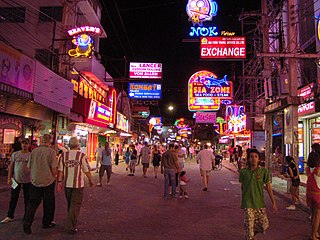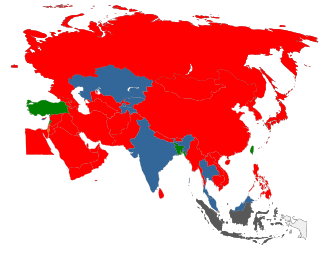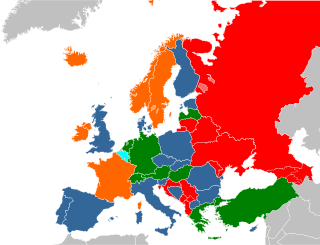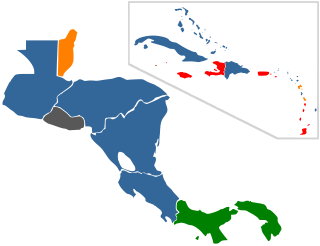Related Research Articles
Child sex tourism (CST) is tourism for the purpose of engaging in the prostitution of children, which is commercially facilitated child sexual abuse. The definition of child in the United Nations Convention on the Rights of the Child is "every human being below the age of 18 years". Child sex tourism results in both mental and physical consequences for the exploited children, which may include sexually transmitted infections, "drug addiction, pregnancy, malnutrition, social ostracism, and death", according to the State Department of the United States. Child sex tourism, part of the multibillion-dollar global sex tourism industry, is a form of child prostitution within the wider issue of commercial sexual exploitation of children. Child sex tourism victimizes approximately 2 million children around the world. The children who perform as prostitutes in the child sex tourism trade often have been lured or abducted into sexual slavery.

Prostitution in the Netherlands is legal and regulated. Operating a brothel is also legal. De Wallen, the largest and best-known Red-light district in Amsterdam, is a destination for international sex tourism.

Prostitution in Thailand is illegal. However, due to police corruption and an economic reliance on prostitution dating back to the Vietnam War, it remains a significant presence in the country. It results from poverty, low levels of education and a lack of employment in rural areas. Prostitutes mostly come from the northeastern (Isan) region of Thailand, from ethnic minorities or from neighbouring countries, especially Cambodia, Myanmar, and Laos. UNAIDS in 2019 estimated the total population of sex workers in Thailand to be 43,000.

The legality of prostitution in Asia varies by country. There is often a significant difference in Asia between prostitution laws and the practice of prostitution. In 2011, the Asian Commission on AIDS estimated there were 10 million sex workers in Asia and 75 million male customers.
Prostitution in the Czech Republic is legal, but organized prostitution is prohibited. Ever since the Czechoslovak Velvet Revolution (1989) led to the creation of the two independent states Czech Republic and Slovakia, prostitution has been flourishing and has contributed its share to the region's booming tourist economy. Prostitution is widespread in Prague and areas near the Republic's western borders with Germany and Austria. In 2002, the Czech Statistical Bureau estimated the trade to be worth six billion crowns a year. UNAIDS estimate there are 13,000 prostitutes in the country.
Prostitution in Guatemala is legal but procuring is prohibited. There is an offence of “aggravated procuring” where a minor is involved. Keeping a brothel is not prohibited.

Prostitution in Mexico is legal under Federal Law. Each of the 31 states enacts its own prostitution laws and policies. Thirteen of the states of Mexico allow and regulate prostitution. Prostitution involving minors under 18 is illegal. Some Mexican cities have enacted "tolerance zones" which allow regulated prostitution and function as red-light districts. In Tuxtla Gutiérrez, capital of the state of Chiapas, there is a state-run brothel at the Zona Galáctica(Galactic Zone). In most parts of the country, pimping is illegal, although pimp-worker relationships still occur, sometimes under female pimps called "madrotas"("Big Mothers"). The government provides shelter for former prostitutes.
Prostitution in Zambia is legal and common. Related activities such as soliciting and procuring are prohibited. UNAIDS estimate there are 9,285 prostitutes in the capital, Lusaka. Many women turn to prostitution due to poverty. Sex workers report law enforcement is corrupt, inconsistent and often abusive.

The legality of prostitution in Europe varies by country.
Prostitution in Guyana is illegal but widespread. Prostitution law is antiquated and dates from the colonial era. Law enforcement is inconsistent and sex workers report violence and abuse by the police. Many turn to prostitution for economic reasons and the lack of other job opportunities. Prostitution continues to receive greater public attention due to the high incidence of HIV/AIDS among prostitutes. Prostitution in the country is separated into three types: "uptown", servicing affluent clients, "downtown", servicing the working classes, and mining sites. UNAIDS estimate there to be 6,000 prostitutes in the country.
Prostitution in Bulgaria is itself legal, but organised prostitution is prohibited. In the past, the Bulgarian government considered fully legalising and regulating prostitution.
Prostitution in Armenia is illegal under administrative law. Related activities such as running a brothel and pimping are prohibited by the Criminal Code, although there are known to be brothels in the capital, Yerevan, and in Gyumri. According to UNESCO, since the collapse of the Soviet Union in 1991, prostitution in the country has grown. There are about 5,600 women involved in prostitution in Armenia, roughly 1,500 of them are in Yerevan. However, official police figures are far lower, for example 240 in 2012. Police and other safety forces reportedly tolerate prostitution. Many women turn to prostitution due to unemployment.

The legal status of prostitution in Africa varies widely. It is frequently common in practice, partially driven by the widespread poverty in many sub-Saharan African countries, and is one of the drivers for the prevalence of AIDS in Africa. Senegal and Côte d'Ivoire permit the operations of brothels. In other countries, prostitution may be legal, but brothels are not allowed to operate. In some countries where prostitution is illegal, the law is rarely enforced.

Prostitution laws varies widely from country to country, and between jurisdictions within a country. At one extreme, prostitution or sex work is legal in some places and regarded as a profession, while at the other extreme, it is considered a severe crime punishable by death in some other places.
Prostitution in Uzbekistan is illegal, but prostitution has increased within the country since the collapse of the Soviet Union. UNAIDS estimated there to be 22,000 sex workers in the country in 2019. Many of the women have turned to prostitution in Uzbekistan because of poverty.
Prostitution in Mongolia is illegal but widespread in some areas. The Global Fund for Tuberculosis, HIV/AIDS and Malaria estimated there were about 19,000 sex workers in the country in 2006. Many women in Mongolia turn to prostitution through poverty.
Prostitution in Tajikistan is legal, but related activities such as soliciting, procuring and brothel keeping are prohibited. Prostitution has increased within the country since the collapse of the Soviet Union. UNAIDS estimate there are 14,100 female sex workers in Tajikistan. Government official figures for 2015 were 1,777 prostitutes and 194 brothels. Prostitution occurs on the streets and in bars, restaurants, nightclubs and saunas, and HIV prevalence is 3.5% amongst sex workers.
Prostitution in Madagascar is legal, and common, especially in tourist areas. Related activities such as soliciting, procuring, living off the earnings of prostitution or keeping a brothel are prohibited. Public Order laws are also used against prostitutes. There are recent laws against "consorting with female prostitutes". People caught paying for sex with children under 14 can face criminal penalties of up to 10 years imprisonment. This is strictly enforced against foreign tourists. As well as in the tourist areas, prostitution also occurs around the mining towns of the interior such as Ilakaka and Andilamena. It was estimated that there were 167,443 sex workers in the country in 2014.
Prostitution in the Democratic Republic of the Congo is legal but related activities are prohibited. The Congolese penal code punishes pimping, running a bawdy house or brothel, the exploitation of debauchery or prostitution, as well as forced prostitution. Activities that incite minors or promote the prostitution of others have been criminalised. The government does little to enforce the law. During the colonial era and the years that followed independence, the Ministry of Health issued calling cards identifying professional sex workers and provided them with medical health checks. However, this system was abandoned in the 1980s. Public order laws are sometimes used against sex workers. Street prostitutes report harassment, violence and extortion from the police. UNAIDS estimated there are 2.9 million sex workers in the country.

Legality of prostitution in the Americas varies by country. Most countries only legalized prostitution, with the act of exchanging money for sexual services legal. The level of enforcement varies by country. One country, the United States, is unique as legality of prostitution is not the responsibility of the federal government, but rather state, territorial, and federal district's responsibility.
References
- ↑ "Prostitution in Estonia" (PDF). EQUAL. Archived from the original (PDF) on 30 September 2011.
- ↑ Jury. "Estonia". Policy.hu. Retrieved 24 July 2012.
- ↑ Report on Human Rights Practices 2008: Estonia. United States Bureau of Democracy, Human Rights, and Labor. This article incorporates text from this source, which is in the public domain.
- ↑ "Estonia also considering criminalisation of purchase of sex". Helsingin Sanomat . Retrieved 11 April 2012.
- ↑ "Sex workers: Population size estimate - Number, 2016". www.aidsinfoonline.org. UNAIDS. Archived from the original on 4 June 2019. Retrieved 21 July 2018.
- ↑ "Global Monitoring on Child Exploitation" (PDF). ECPAT . Archived from the original (PDF) on 11 June 2013.
- 1 2 "Estonia 2018 Trafficking in Persons Report". U.S. Department of State. Archived from the original on 29 July 2018. Retrieved 28 July 2018.
 This article incorporates text from this source, which is in the public domain .
This article incorporates text from this source, which is in the public domain .